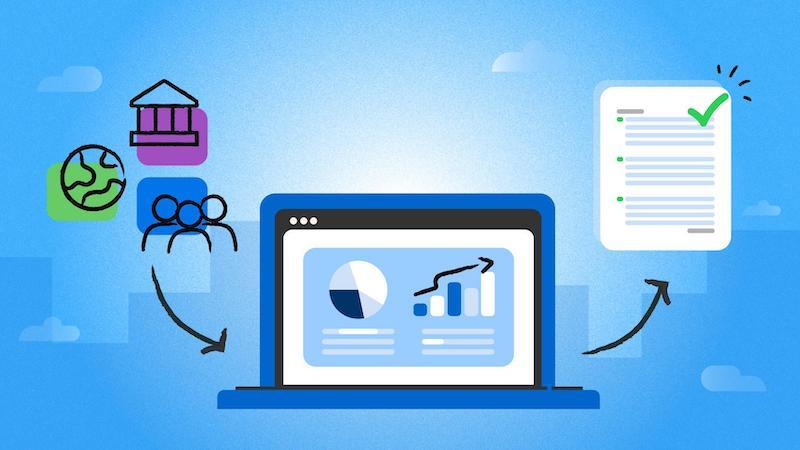Where To Start with ESG? Technology. Here's Why

Originally published on Workiva
By Abhay Krishna, Director of Value Management, Workiva
I heard someone say recently that companies that have not yet started to create environmental, social, and governance (ESG) reports are data-rich but information-poor. So true.
These organizations have utility bills, data on workforce demographics, training metrics, customer privacy and data security policies, commitments to human rights, sourcing and supplier diversity statistics, and countless other sources flying around their data ecosystem, but no ESG insights or reports.
So why is it so hard to turn data into informative insights?
Some organizations don’t know what to report, how to collect the data, and how to effectively report it. Others simply don’t have enough resources to do the work. Still others lack confidence in the data to disclose anything externally.
Whether the constraint is knowledge, resources, or confidence, technology can help close the gap between data and information. Here are five reasons companies are leveraging technology as they embark on their ESG journeys.
How ESG reporting technology helps
1. Simplify how you set your ESG strategy
At the beginning of an organization’s ESG journey, the typical question is what should I focus on and report? Setting ESG strategy usually involves conducting a materiality assessment, researching peer ESG performance, reviewing ESG frameworks and standards, and using those as a basis to help determine what to focus on and how to disclose related ESG performance.
Done manually, this can be a daunting exercise, toggling between various reporting standard-setters’ websites, extracting their requirements to spreadsheets, emailing questionnaires to stakeholders, and consolidating their responses.
How Workiva helps: Workiva developed ESG Path, which provides a strong foundation to help set your ESG strategy with our built-in materiality assessment, framework explorer, and industry-driven ESG topic finder.
2. Establish scalable, efficient, and controlled processes from the get-go
Once the strategy is set, defining the ESG reporting process requires figuring out how to collect data efficiently and reporting it in a highly controlled, auditable way. That means no copying and pasting, having supporting documentation and audit evidence on demand, and marrying data and narrative. Getting these processes right can be complicated, particularly when they don’t exist.
How Workiva helps: Workiva has embedded pre-configured data collection templates, workflows, and linked reporting templates into ESG Path from our experiences transforming reporting for hundreds of companies to help you establish a highly controlled, efficient process from the beginning. You can build a strong foundation for audit-ready ESG reporting with a platform that scales with you as your ESG program matures, as Exxaro found when building its tech-enabled ESG reporting process with Workiva.
3. Gain efficiencies to free up time for more strategic work
ESG reporting can be highly manual, tedious work that requires collecting data, aggregating it in a master file, and copying and pasting it into reports and presentations while reviewing supporting documentation that may exist elsewhere. Or it can be highly strategic work engaging with stakeholders, benchmarking peers, tracking commitments versus actuals, and transforming the business. Your choice, but it does become an either/or when late nights and weekends are at stake.
How Workiva helps: Workiva’s ESG Path can help take care of the mundane, repeatable, low-judgment tasks and free up your time to do what matters most, both in the early days and longer term. Automate data gathering, and create time for more strategic planning and alignment. It’ll pay off.
4. Establish confidence in your data when internal scrutiny is at its peak
Publicly disclosing something for the first time draws a lot of internal scrutiny. The legal department has questions about the risks and cost-benefit analysis of disclosing more. Investor relations has questions about the overall narrative. All stakeholders need to know there is enough evidence to back up the ESG story that you’ve been busy crafting. Do you want to pull up that evidence one by one in fragmented spreadsheets sitting in your inbox, or do you want to show that evidence effortlessly in context, inline as you’re reviewing the reports with your ESG steering committee?
How Workiva helps: ESG Path enables you to link data points, attach documentation, and automatically capture an audit trail. This helps you lay the foundation for strong data governance and establish trust with stakeholders in your disclosures.
5. Be future-proof
ESG reporting involves a dynamic ecosystem, where stakeholders’ needs evolve day to day. Customers are asking for more data from their suppliers, investors need more data from their portfolio companies, employees need more data from their employers, and regulators are mandating additional ESG disclosures. New frameworks, raters, and rankers are emerging. Foreign, state, and local governments are creating rules. There is talk about harmonization and convergence of reporting rules, XBRL® tagging of data, and electronic filing. How will you handle all this change?
How Workiva helps: Workiva’s ESG Path can help you establish the foundation for aggregating all your data and creating consistent reports and presentations to meet stakeholders’ evolving needs. Whether you want to start including ESG data in financial reports, filing ESG data electronically with the Securities and Exchange Commission (SEC), preparing for external assurance of data, or adding XBRL tags to data, Workiva can help.
Request a demo to see how you can use ESG Path to lay the foundation for strong reporting.
XBRL® is a trademark of XBRL International, Inc. All rights reserved. The XBRLTM/® standards are open and freely licensed by way of the XBRL International License Agreement.

